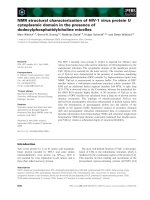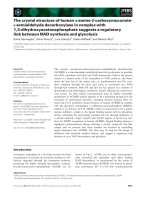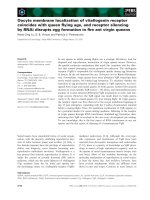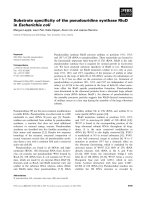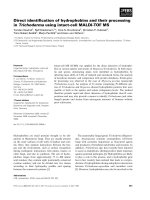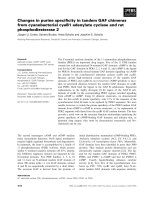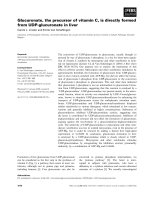Tài liệu Báo cáo khoa học: "Experiments in Reusability of Grammatical Resources" pot
Bạn đang xem bản rút gọn của tài liệu. Xem và tải ngay bản đầy đủ của tài liệu tại đây (856.94 KB, 9 trang )
Experiments in Reusability of Grammatical Resources
Doug Arnold ° Toni Badia ®, Josef van Genabith% Stella Markantonatou °
Stefan Momma% Louisa Sadler °, Paul Schmidt °
°Dept of Language and Linguistics, University of Essex, Colchester C04 3SQ, UK
°Universitat Pompeu Fabra, La Ramba 32, 08002 Barcelona, Spain
°IMS-CL, Azenbergstrafle 12, University of Stuttgart, D-W7000 Stuttgart, Germany
DIAI, Martin-Luther-Strai~e 14, D-W6600 Sa~rbrficken 3, Germany
doug;marks;, ,
steff;,
Abstract 1 Introduction
Substantial formal grammatical and lex-
ical resources exist in various NLP sys-
tems and in the form of textbook speci-
fications. In the present paper we report
on experimental results obtained in man-
ual, semi-antomatic and automatic migra-
tion of entire computational or textbook de-
scriptions (as opposed to a more informal
reuse of ideas or the design of a single "poly-
theoretic" representation) from a variety
of formalisms into the ALEP formalism. 1
The choice of ALEP (a comparatively lean,
typed feature structure formalism based on
rewrite rules) was motivated by the as-
sumption that the study would be most
interesting if the target formalism is rel-
atively mainstream without overt ideolog-
ical commitments to particular grammat-
ical theories. As regards the source for-
malisms we have attempted migrations of
descriptions in HPSG (which uses fully-
typed feature structures and has a strong
'non-derivational' flavour), ETS (an un-
typed stratificational formalism which es-
sentially uses rewrite rules for feature struc-
tures and has run-time non-monotonic de-
vices) and LFG (which is an un-typed con-
straint and CF-PSG based formalism with
extensions such as existential, negative and
global well-formedness constraints).
1 The work reported in this paper was
supported
by
the CEC as part of the project ET10/52.
Reusability of grammatical resources is an important
idea. Practically, it has obvious economic benefits in
allowing grammars to be developed cheaply; for the-
oreticians it is important in allowing new formalisms
to be tested out, quickly and in depth, by providing
large-scale grammars. It is timely since substantial
computational grammatical resources exist in vari-
ous NLP systems, and large scale descriptions must
be quickly produced if applications are to succeed.
Meanwhile, in the CL community, there is a percep-
tible paradigm shift towards typed feature structure
and constraint based systems and, if successful, mi-
gration allows such systems to be equipped with large
bodies of descriptions drawn from existing resources.
In principle, there are two approaches to achiev-
ing the reuse of grammatical and lexical resources.
The first involves storing or developing resources in
some theory neutral representation language, and is
probably impossible in the current state of knowl-
edge. In this paper, we focus on reusability through
migration the
transfer of linguistic resources (gram-
matical and lexical descriptions) from one compu-
tational formalism into another (a target computa-
tional formalism). Migration can be completely man-
ual (as when a linguist attempts to encode the analy-
ses of a particular linguistic theory in some compu-
tationally interpreted formalism), semi-automatic or
automatic. The starting resource can be a paper de-
scription or an implemented, runnable grammar.
The literature on migration is thin, and practical
experience is episodic at best. Shieber's work (e.g.
[Shieber 1988]) is relevant, but this was concerned
with relations between formalisms, rather than on
migrating grammars
per se.
He studied the extent
to which the formalisms of FUG, LFG and GPSG
could be reduced to PATlt-II. Although these stud-
12
ies explored the expressivity of the different grammar
formalisms (both in the strong mathematical
and
in
the functional sense, i.e. not only which class of
string sets can be described, but also what can be
stated directly or naturally, as opposed to just being
encoded somehow or other), the reduction was not
intended to be the basis of migration of descriptions
written in the formalisms. In this respect the work
described below differs substantially from Shieber's
work: our goal has to be to provide grammars in the
target formalisms that can be directly used for fur-
ther work by linguists, e.g. extending the coverage or
restructuring the description to express new insights,
etc.
The idea of migration raises some general ques-
tions.
• What counts as
successful
migration? (e.g.
what properties must the output/target descrip-
tion have and which of these properties are cru-
cial for the reuse of the target description?).
• How conceptually close must source and target
be for migration to be successful?
• How far is it possible to migrate descriptions ex-
pressed in a richer formalism (e.g. one that uses
many expressive devices) into a poorer formal-
ism? For example, which higher level expres-
sive devices can be directly expressed in a 'lean'
formalism, which ones might be compiled down
into a lean formalism, and which ones are truly
problematic? Are there any general hints that
might be given for any particular class of higher
level expressive devices? When should effort be
put into finding encodings for richer devices, and
when should the effort go into simply
extending
the target formalism?
• How important is it that the source formalism
have a well-defined semantics? How far can
difficulties in this area be off-set if the gram-
mars/descriptions are well-documented?
• How does the existence of non-monotonic de-
vices within a source formalism effect migrata-
bility, and is it possible to identify, for a given
source grammar, uses of these mechanisms that
are not truly non-monotonic in nature and could
thus still be modelled inside a monotonic de-
scription?
• To what extent are macros and preprocessors a
useful tool in a step-wise migration from source
to target?
We can provide some answers in advance of ex-
perimentation. In particular,
successful
migration
implies that the target description must be practi-
cally usablc that is, understandable and extensible.
There is one exception to this, which is where a large
grammatical resource is migrated solely to test
the
(run-time) capabilities of a target formalism. Practi-
cally, usability implies at least I/O equivalence with
the source grammar but should .ideally also imply the
preservation of general properties such as modular-
ity, compactness and user-friendliness of the specifi-
cation.
This paper reports on and derives some lessons
from a series of on-going experiments in which
we have attempted automatic, semi-automatic and
manual migration of implemented grammatical and
lexical resources and of textbook specifications, writ-
ten in various 'styles', to the
ALEP
formalism (see
below). The choice of ALEP was motivated by the
assumption the study would be most interesting if
the target formalism is relatively mainstream. 2 As
regards the 'style' and expressivity of source for-
malisms, we have carried out migrations from HPSG,
which uses fully-typed feature structures and a vari-
ety of richly expressive devices, from ETS grammars
and lexicons 3 (ETS is an untyped stratificational
formalism essentially using rewrite rules for feature
structures), and from an LFG grammar 4 (LFG is a
standard untyped AVS formalism with some exten-
sions, with a CFG backbone).
2 The Migration Experiments
2.1 The Target Formalism
The target formalism, ALEP, is a first prototype im-
plementation of the formalism specified in the ET-
6 design study (the ET-6 formalism [Alshawi et
al.
1991]). ET-6 was intended to be an efficient, main-
stream CL formalism without ideological commit-
ments to particular grammatical theories and suit-
able for large-scale implementations. It is declara-
tive, monotonic and reversible, although in ET-6 and
in ALEP it is possible to model certain non-monotonic
operations (e.g. getting some treatment of defaults
out of parametrised macros). ALEP is CF-PSG rule
based and supports feature structures which are
typed and simple inheritance between types. Type
information and inheritance is effective only at com-
pile time. ALEP provides atoms, lists, booleans and
terms as basic types. Complex structured types and
simple inheritance relations are defined by the user in
a type system specification. In addition to standard
grammar rules which are effective during a parse
(generation) the formalism provides refinement rules
which operate on the output of the parser and spec-
ify values which are still undefined after parsing by
using only unification. Although the core formal-
ism is rather conservative, for reasons of efficiency,
it is intended to support the eventual inclusion of
a periphery including external constraint processing
20f course, for practical
purposes one might want to
migrate resources to a non-standaxd formalism, provided
it is relatively easy to understand.
3Developed at Saaxbrficken, Essex and UMIST
during
the
EUROTRA project.
4Developed at Stuttgart
as part of the EUROTRA
accompanying research, see [Meier 1992].
13
modules. Similarly, it does not (yet) directly provide
potentially computationally expensive expressive de-
vices such as e.g. set-valued features and operations
on sets, functionally dependent vMues, separation of
ID and LP statements, multiple inheritance or mem-
bership and concatenation constraints on lists. The
idea is that such extensions should be provided, prob-
ably as external modules, as and when they are found
to be necessary. 5
2.2 Manual Migration from HPSG
Although both HPSG and ALEP use typed feature
structures and support type inheritance, they dif-
fer crucially in that HPSG specifications are con-
sciously non-derivational and strongly modularised
in terms of sets of principles, immediate dominance
schemata and linear precedence statements operat-
ing as constraints on typed feature structures. To
achieve this, HPSG employs a number of powerful
descriptive devices, including list and set operations
(often expressed as functionally dependent values),
and multiple type inheritance. The focus for the
HPSG
, ALEP
conversion, then, is to what ex-
tent can the latter, rather lean formalism support in
a reasonable way the style of linguistic specification
found in HPSG (the source specifications for this ex-
eriment was the description of English provided in
ollard & Sag 1992]).
Various approaches to conversion are possible. For
example, it would be possible to define a user lan-
guage permitting the expression of principles (in
much the same way as some formalisms permit fea-
ture percolation principles to be separately stated)
and a compiler into ALEP allowing their effects to
be expanded into the rules. In this spirit, follow-
ing the work of Mellish [Mellish 1988] the technique
of encoding boolean combinations of atomic feature
values so that satisfaction can be checked by unifi-
cation is adopted in the ET-6 formalism [Alshawi et
al.
1991].
Since there were open questions as what could be
directly expressed in ALEP, in this conversion experi-
ment we first took a direct approach, essentially em-
ploying ALEP as a feature term rewriting system for
HPSG specifications. The focus of this conversion
was mainly on exploring the limits of the expressiv-
ity of ALEP and thus identifying which higher level
expressive devices could not be treated.
The resulting translation is not as perspicuous,
modular, compact and maintainable as the original
HPSG specification. Migration results in a fragmen-
tation and particularisation of the linguistic infor-
mation encoded in the original specification. This is
because (i) HPSG principles and schemata have to
be compiled out into (possibly large) sets of ALEP
SApart from investigating issues involved in migration
of descriptions, one motivation for these experiments is
to explore just which devices are essential for expressing
linguistically motivated grammatical descriptions.
phrase-structure rules; and (ii) some descriptions
cast in a richly expressive formalism have to be sim-
ulated and can often only be approximated in ALEP.
For example, ID-2 and the valence principle as it
applies to ID-2, (1) has to be approximated with sets
of ALEP rules of the form in (2), because of the lack
of the functional constraint
val_append.
(1) ID-2 and Valence Principle (simplified):
[SYlgSEM [ LOC [ CAT [ COMPS e
1
DRTS l HDTR[ SYNSEN [ L0C l CAT l CONPS val_append(@ 1, @2)
COMPDTRS @2]
(2) ALEP rules for ID2:
id_2_0 = sign:{ comps =>
I']
} ->
[sign:{ comps => [] }] head 1.
id_2_1 = sign:{ comps => [] } ->
[sign:{ comps => IX] },
sign:{
synsel => X }] head 1.
id_2_2 = sign:{ comps -> [] } ->
[sign:{ comps => IX,Y]
},
sign:{ synsel -> I },
sign:{ synsel => Y
}]
head 1.
id_2_3 = .
Of course, by adopting binary branching trees and
altering the ID and Subcategorisation principles it
would be possible to avoid some of this verbosity, but
for the purposes of our experiment we considered it
important to investigate the migration of the source
formalism as is.
Note that the resulting ALEP specification in (2) is
as compact, perspicuous and maintainable as in any
rule based grammar formalism, although it compares
badly with HPSG in these terms. While initially it
seemed that it was possible to create a usable, ex-
tensible and understandable ALEP grammar on the
basis of HPSG specifications, there is one feature of
HPSG which remains problematic, that of set-valued
features and set operations. The difficulty comes in
modelling principles such as the HPSG Quantifier
Inheritance Principle (QIP), which relies on the op-
erations such as set union and complementation.
In
ALEP
set union can be approximated to a certain
extent in terms of list concatenation in a difference
list based threading approach. However, since the
current implementation of ALEP does not even pro-
vide membership constraints on list representations,
element and set difference constraints can only be ap-
proximated in terms of a multitude of minimally dif-
fering rules naming elements in set representations.
This approach is only safe if the following two con-
ditions hold:
• the sets involved are finite
• elements in the difference list representations of
sets are unique
Even for small sets, however, any exhaustive im-
plementation of set difference in terms of naming el-
14
"SYNSEM: [LOC:
[CONTENT:[QUANTS:RETR U
HQUANTS]]]
QSTORE:(HQSTORE U QUANTS1 U U QUANTS,}- RETR
RETRVD:RETR
FHDTR:[SYNSEM:[LOC:
[CONTENT:[QUANTS:HQUANTS]]
]]]
DTRS:
I °TRI
IQSTO.] RE:QuANTSI]
J
LDTR.
[QSTORE:QUANTS,]
Figure h Quantifier Inheritance Principle (simplified)
ements in the representation results in an unaccept-
able number of rules and associated parse time. In
some cases we were able to avoid this problem by
relegating e.g. quantifier retrieval to sets of refine-
ment rules which operate on parse objects which are
effectively underspecified for quantifier scope.
It soon became clear that sets of refinement rules
are not a general solution for the modelling of el-
ement or set complement constraints in HPSG be-
cause they operate on the
output
of a parse and
hence cannot decide about the 'phrase' structure of
a sign. Introducing and filling gaps, however, is cen-
tral to the structure of a sign. The Nonlocal Feature
Principle (NFP) which is at the heart of the ttPSG
treatment of unbounded dependency constructions
(UDCs) ensures that SYNSEM I NONLOC I INHER values
are discharged in terms of a set difference specifica-
tion which cannot be implemented in terms of sets
of refinement rules since it directly decides about
the well-formedness of strings in terms of the phrase
structure of the sign.
IOTR.: [SYNSEM:[NONtOC:tINHER:Sn]]]
Figure 2: Nonlocal Feature Principle (simplified)
Furthermore, parasitic gap phenomena in English as
in
That was the rebel leader who rivals of_ shot _
suggest that at least as far as the NFP is concerned
it is problematic to asssume that elements in the dif-
ference list representations of sets are unique. This
assumption is crucial to modeling set union in terms
of list concatenation.
Formally, HPSG principles can either be given the
status of proper types or that of typed feature struc-
ture templates acting as constraints on other feature
structures. In
ALEP
the first option is not available
to us since apart from subtype or supertype infor-
mation the type system specification does not allow
the specification of a type other than in terms of
its root attributes and the type of their correspond-
ing values and more importantly it does not support
multiple inheritance required to inherit principles to
other types. In order to recapture some of the loss of
modularity in compiling out HPSG principles over
sets of ALEP rules we thus tried to pursue the sec-
ond option using m4 macros to directly state princi-
ples. m4 is a standard UNIX facility which allows for
parameterised and non-parameterised macros, con-
ditional expansions and numeric operations. Macros
are expanded externally to ALEP and not during com-
pilation time. Each HPSG principle can be rep-
resented as a feature structure template which in
turn can be specified in terms of a macro defini-
tion, or so it seems. The problem here, however, is
that since IIPSG principles mutually constrain signs,
the conjunction of such principles (at least in simple
cases) corresponds to the unification (or merging) of
their feature structure template representations (if
the conjunction is satisfiable). What standard macro
facilities achieve is effectively a simple lexical expan-
sion of strings and it is impossible to get the merging
effect of unification of template feature structures out
of a modular macro specification of such templates.
Basically, three options are available to us:
(i) To get the overlapping effect of unification we
integrate different principles into one macro.
(ii) We define extended types with special attributes
for each of the relevant HPSG principles which
are expanded by modular macro definitions of
the principles and get the unification effect from
ALEP
at compile time through proper coindexa-
tion.
phrase{phrase ffi> QS{PHRASE},
hfp
ffi> @S{HEAD_FEATURE_PRINC},
sp
~> @S{SEMANTICS_PRINC},
qip -> QS{QUANTIF_INHERIT_PRINC},
valp => GS{VALENCY_PRINC}}
(iii) We use a more powerful 'macro' processor like
e.g. Prolog which provides the unification effect
and define a map into ALEP.
In the case of (i) the modularity of ttPSG with
separately stated, but interacting principles is lost.
(ii) hasthe disadvantage that the
ALEP
specifications
grow in size while in the case of (iii) we are not con-
15
sidering the expressivity of the target formalism it-
self.
2.3 Automatic Migration from ETS B-rules
In this section we draw some general conclusions
following from our experience of attempting auto-
matic migration from an untyped rule-based formal-
ism. Specifically, the source for this experiment was
the structure-building rules of some relatively large
ETS grammars. The ETS formalism is "badly be-
haved" in that it contains a rich array of devices ad-
ditional to the structure-building or B-rules, many of
which are non-monotonic, and which apply at run-
tim e (they are mainly output filters and various types
of feature percolation rules). We have written an au-
tomatic compiler in Prolog which calculates a very
simple type system and automatically migrates the
structure rules and lexical descriptions. With respect
to the source formalism in question, the following
points are to be noted:
• The run-time non-monotonic devices found in
ETS are extremely problematic to take into ac-
count in automatic direct migration. We doubt
whether it would be possible to write an intelli-
gent compiler which directly encoded the effect
of these devices in the resultant
ALEP
rule set. If
they are ignored in the migration process, then
of course the source and target descriptions are
not I/O equivalent.
• The B-rules themselves allow optionality, Kleene
closure, positive Kleene closure and disjunction
over (sequences of) daughters to any degree of
embedding within each other. In ALEP such
rules have to be compiled out into a normal
form which allows only for optionality over sin-
gle daughters and no disjunctions of daughters.
The size of the resulting rule set is such that
it cannot be reasonably maintained. The size
also means that it is impossible for a linguist to
manually "correct" an overgenerating grammar
resulting from the omission of filters and feature
rules above.
• In some cases, it became apparent during the
migration process that the intended semantics
of the (very complex) phrase structure rules was
unclear (e.g. regarding the scope of variables in
Kleene starred constituents).
One conclusion is that one of the crucial ingredi-
ents is the quality and detail of the documentation
of grammars. With good documentation it is often
possible to get around the effects of unclear rule se-
mantics, because the rule writers intention can be
understood. The lack of such documentation is se-
rious, since it means the migrator has to try to in-
tuit the intended behaviour by attempting to run the
source grammars in the source formalism.
Similarly, so long as the intended interpretation is
clear, it may be possible to deal with non-monotonic
devices. This is most obvious where the non-
monotonic effects do not persist to run-time (but
see also our discussion of the LFG migration below).
For example the ALVEY grammar [Carroll 1991] has
them, but since there is an object grammar stage
in which all this is compiled out, the non-montonic
devices can be avoided by taking the object gram-
mar as the input to migration. The issue is then
whether it is possible to automatically 'recompact'
the target grammar in some linguistically useful way,
or whether all extension and maintenance should be
done in the source formalism.
Note further that even if the grammars resulting
from a migration are not linguistically useful (for ex-
ample, because the grammar is not maintainable or
extensible), they may serve some purpose in testing
the capacity of the target formalism to operate (ef-
ficiently) with very large rule sets (for example, in
our experimentation, a rule set of some 1,500 rules
derived by automatic migration caused ALEP to fail
to compute the link relation).
ETS lexical descriptions are more successfully mi-
gratable because their semantics is clear. Simple
parameterised macros have been used in a semi-
automatic migration process.
2.4 Automatic LFG
importation into
ALEP
LFG is an untyped constraint-based linguistic for-
realism with rich expressive devices built around a
CFG backbone. The formalism has been imple-
mented in various systems, including XEROX PARC's
Grammar Writer's Workbench, and the CHARON
system developed as part of the accompanying re-
search for EUROTRA-D carried out at the University
of Stuttgart. Our automatic migration experiment
started from grammars written for the latter system.
We have written a Prolog program that translates
automatically from an LFG notation that is very
close to the original specification in [Bresnan 1982]
into ALEP.
For reasons explained further below, the
program cannot succeed in all cases. It is, however,
capable of detecting those cases reliably, and gener-
ates warnings where the fully automatic translation
fails. 6 Examples for typical rules from the source
grammar are shown in figure 3. 7
The translation of the rule format illustrated in fig-
ure 3 into a PROLOG readable form is performed by
a subcomponent of the CHARON system. The auto-
matic translation procedure makes use of the output
of this precompilation step.
The rule format supports optionality of con-
stituents, nested optionalities and Kleene starred
rule parts, which have to be expanded in the ALI,~P
translation.
ALEP
only supports optionality of single
daughters in the RHS of rules. In our case, this part
of the expansion is done by the preprocessor. The
eThe program
was developed
by Dieter Kohl at IMS.
7The caret sign and the lowercase v are ASCII
repre-
sentations of the metavariables T and 1,
respectively.
16
VP'' -> VP'
[v
{/ (- vco~) = v
/ =v /}
V].
Cl
->
C
VP2
= v
{/ " =
v
{/(" VTYPE) =
v2
/(" VTYPE) =
vl
/}
[(" FCOMP) =
v
{/ (" VTYPE) = v:fin
/ (" VTYPE) = inf /}
/}.
Figure 3: Sample grammar rules from the source de-
scription
result of compiling out Kleene starred rules and op-
tionalities is that the object grammar quickly reaches
a size that can no longer be reasonably maintained
and the target description contains elements (in this
case auxiliary categories) which are not part of the
linguistic intuition of the grammar writer.
The second characteristic feature of rules like the
ones shown in figure 3 is the massive use of complex
disjunctions over feature structures (indicated by the
{\
and
\}
pairs). Although the
ALEP
formalism sup-
ports disjunctions over complex feature structures,
due to problems in the implementation available at
the time of the experiment, they had to be multiplied
out into a possibly large number of separate rules.
The next example (figure 4) shows a typical lexical
entry from the source grammar.
bietet: V,
(~ OBJ AGR CAS) =acc
(" PLIED) =
"bieten <("
SUBJ)("
OBJ)>"
(" SUBJ AGE Bq/M)
=
sg
(" SUBJ AGR CAS = nora
(" TENSE) = present
(" INF)
=-
(" FORM) =c
an <
(" VERBTYPE)
=
particle.
Figure 4: Sample lexicon entry from the source de-
scription
The basic part of the annotations of the LFG rules
and lexicon, i.e. the defining equations, are mapped
easily into ALEP. The work here is divided between
the CHARON preprocessor which converts feature de-
scriptions (the equations) into feature terms, and the
output routine which maps feature terms into ALEP
rules and lexicon entries.
In LFG, path specifications in equations can be
variables, as in the (" (v PCASE)) case, where the at-
tribute under which the f-structure associated with v
is determined by the value of a feature inside v. ALEP
does not support variable path expressions, therefore
we have to enumerate all possible paths in a large dis-
junction which adds another factor to the multiplica-
tive expansion of the rule set. Similar facts hold for
the implementation of functional uncertainty, where
we have to deal with regular expressions over paths, s
LFG permits "special" types of equation besides
the standard defining ones. Constraining (=c type)
equations in our source grammar typically occur in
lexical entries as the one shown in figure 4, where
a given form of e.g. a verb has to be distinguished,
because it is only used in particular contexts. The
equation is then typically a specification of a special
subclass of a more general class of verbs (here a verb
which can occur with a separable prefix). Where this
is the case, in the migrated description the relevant
distinction can be made in the type system, ensur-
ing that non-membership in the particular subtype
is explicitly stated for all (relevant) members of the
supertype.
Another, potentially very powerful expressive de-
vice in the LFG formalism is the use of existential
and negative existential constraints (in the CHARON
notation expressed as !(" INF) and "(" INF), re-
spectively). Current implementations of LFG delay
the evaluation of such constraints, because in gen-
eral, they can only be tested at the end of the pro-
cessing of a whole utterance. It turns out, however,
that quite often existential and negative existential
constraints can be disposed of, if a full type sys-
tem is available. Careful examination of the source
grammars reveals that the prevalent use of such con-
straints is exactly to model what feature appropriate-
ness conditions in a type system do: they restrict the
application of particular rule types to feature struc-
tures where a given set of features is either present or
absent. To model this by using the type system in-
stead, we introduce subtypes of the structure where
the path has to or must not exist.
If the source grammar only uses negative existen-
tial constraints for atomic valued features, we could
easily formulate a proper type system, and do away
with '-', and '!' in a rather straightforward manner.
Typical uses of e.g. negative existential constraints
are shown in the rule and lexical entry in figure 5.
LFG uses set values for collecting e.g. adjuncts
which do not have any other distinguishing function
on the f-structure level. ALEP does not support the
direct expression of sets as values. Given the facts
of German word order, generation would seem to re-
quire sets of ADJUNCTS as values, rather than lists.
Here we do in fact loose some expressivity if we try
to model adjuncts in ALEP using lists, because the
canonical set operations are not available.
Finally, we have to be able to express the (non-
monotonic) global completeness and coherence con-
Sin a recent experiment, the implementors of the
CHARON system added support for functional uncer-
tainty modelled via an interpretation of paths as se-
quences and general operations on these sequences.
17
C ->V •V
{/(" VTYPE) = v2
/(" VTYPE) ffi vl /}
"("
INF).
kennen:
V, (" PRED) ffi "kennen<(" SUBJ)(* 0BJ)>"
(" OBJ AGR CAS) = ace
(/ (" SUBJ
AGR ~OM) ffi pl
(" SUBJ AGR CIS) =
nora
(" TENSE)
present
" (- I~F)
/ (" INF PEPS)
("
U~ACC)
= -
/}.
Figure 5: Examples for negative existential con-
straints in the rules and the lexicon
straints which help to control subcategorisation. Of
these two, the coherence condition can be easily con-
trolled by defining types with the appropriate num-
ber of features, one for each of the subcategorised
functions. The introduction of additional syntactic
functions which are not subcategorised for is then
prevented by the type system. The completeness
condition, however, which is supposed to guarantee
that all syntactic functions in the subcategorisation
frame are filled, can not be handled that easily. The
main problem here is, that while we are able to re-
quire that a certain feature be present in a feature
structure, we cannot express restrictions on the de-
gree of instantiation of the value of that feature.
There is, of course, another option: If we model
subcategorisation more explicitly, introducing 'sub-
cat lists' as data structures in much the same way
as HPSG does, we can add the requirement that PS
rules consume elements of the subcat list. Besides
the question whether such a modelling is still com-
patible with the spirit of LFG theory as it stands,
the proposed solution does not solve the problem
for a German LFG grammar: in order to model
the variability of German word order, we have to
be able to pick arbitrary elements from the subcat
list, rather than relying on a fixed order in which ele-
ments are picked. Since list operations (or functional
constraints in general) are not available in ALEP, this
can currently not be modelled perspiciously.
In summary, then, the philosophy of the grammar
can be maintained, and a type system can be pro-
vided. To a certain extent, it can express LFG's
non-monotonic devices such as existential, negative
existential and constraining equations and the global
wellformedness constraints of completeness and co-
herence. The target grammar is less compact, be-
cause generalisations are lost, through the multi-
plicatory effect of spelling out optionalities, Kleene
stars and variables over attribute names.
2.5 Technical description of the automatic
conversion procedure
The automatic conversion has to accomplish three
basic tasks:
• A conversion of the grammar rules into ALEP
format
• A conversion of lexical entries into the ALEP
lexicon format
• The extraction of a certain amount of type in-
formation from the LFG grammar to be used in
the ALEP descriptions. 9
We will not go into details of the CHARON pre-
compilation, since the techniques employed are stan-
dard (expansion of optionality and Kleene star con-
stituents, as well as compilation of feature descrip-
tions into feature terms). As regards the extraction
of type information from the untyped LFG descrip-
tion, more explanation is needed, however.
In the current incarnation of the conversion rou-
tine, the following strategies are used:
• each attribute is assigned (at least) one type
name
• atomic-valued features and
PREDS
are used dur-
ing compilation to compute value ranges for
their corresponding types
• features with complex values have their possi-
ble values (and the attributes therein) collected
during compilation, and the compiler then de-
termines the corresponding types at the end of
the compilation.
• the output routines take care of the fact that
types that represent atomic values or terms are
spelt out correctly (i.e. that they do not show
up as type definitions, but are inserted directly)
• if we encounter more than one type name for
the value of a given attribute, further processing
is necessary, because reentrancies are involved
or we have an interaction with the e-structure
skeleton which has to be handled separately.
In all those cases, where the compilation cannot pro-
duce satisfactory results, the intermediate structures
are printed out instead, together with a comment
saying which steps failed indicating where further
hand-tuning is required.
In particular,
• sets are encoded as open ended lists, thus not
solving the free order problem mentioned above
• the uniqueness condition is marked through the
use of a term for the value of
PRED
• for compilation steps which modify the original
structure of the grammar (e.g. turning inequa-
tions in finite domains into disjunctions, map-
ping constraining equations onto defining ones,
if the automatic inference of the proper subtypes
°We also have to provide the ALEP runtime
sys-
tem
with information about
headness in grammar rules,
which is crucial
for the proper operation
of at
least one
of the parser modules
provided with
the system.
18
is not yet possible, etc.) a warning is issued in
the resulting ALEP code in the form of a com-
ment
s headness information is selected according to
the following heuristics:
- derivation to e have no head information
associated (naturally)
- unary-branching nodes have a trivial head
- for non-unary-branching rules
* those categories that can rewrite to e are
eliminated from the list of head candi-
dates (if all daughter nodes are elimi-
nated this way, the first daughter is se-
lected as the head, and a comment ap-
pears with the rule)
* if pure preterminal nodes are among the
remaining ones, the first one is selected
as the head
. otherwise, all left-recursive nodes are
eliminated (with a similar strategy for
taking the remaining leftmost node, if
all nodes would be eliminated)
. among the remaining nodes, again the
leftmost node is selected as the head
* if everything is left-recursive, the left-
most node is selected, and a comment is
generated accordingly in the output.
Compiling out the rule given in figure 3 yields
(among others) the ALEP structure in figure 6, the
result of the compilation of the lexical entry from
figure 5 is shown in figure 7 (again, only one of the
disjuncts is shown).
vp2_vp_v =
ld:
{ spec => get_Specifier_t: { },
syn
=> vp2_Syntax_t: { },
fs
=> QV_FS vp_Cat_t:
{ vcomp -> Vp_I_FS},
pho => phones: { string -> Vp_Str,
rest => Rest } }
->
[ld:
{
syn => vp_Syntax t:
{
},
fs => Vp_I_FS,
pho => phones:{ string => Vp_Str,
rest => V_Str } }
ld: { syn => v_Syntax_t: { },
fs => V_FS,
pho => phones: { string => V_Str,
rest
=>
Rest } }]
head 2.
Figure 6: Compiled rule from figure 1
3
Conclusion
Our experiments have demonstrated that migrations
of various sorts can be performed with a reasonable
degree of success.
kennen "
Id:
{spec => get_Specifier_t: {},
pho =>
phones:
{string-> [kennen [ R],
rest => R},
syn
=> v_Syntax_t: { },
subcat =>[ld:
{syn => alp_Syntax_t:
{},
fs
=> Subj},
ld:
{ syn => dp_Syntax_t: {},
fs => Obj}],
fs => cpl_Cat_t:
{ pred -> pred_FS_t:
{semuame => kennen,
semargs => suhj_obj},
subj "> @Subj
dp_Cat_t:
{pred "> _},
obj
-> @Obj dp_Cat_t:
{pred => _,
asr -> agr_FS_t :
{ cas -> ace}},
inf -> inf_FS_t_kv: {perf => -},
unacc
=>
-}}.
Figure 7: Compiled lexical entry from figure 3
As regards the general questions about migration
posed at the beginning, we can formulate some (par-
tial) answers.
• Successful migration obviously involves more
than just I/O equivalence of source and target
descriptions. One also looks for similar degrees
of 'descriptive adequacy' (i.e. compactness, per-
spicuity, maintainability etc.). Clearly reusabil-
ity implies usability. However, this is not an ab-
solute property, and a small loss of such proper-
ties can be acceptable. It is clear, however, that
the loss of maintainability that we have experi-
enced in some of the migration activities above
is unacceptable.
• How conceptually close must source and target
be for migration to be successful? We have seen
that in principle it is possible to migrate re-
sources across certain formal/ideological divides
for example, from ttPSG, which has no rules,
but uses types extensively, to ALE]', which has a
weaker type system, and is CF-PSG rule based;
and from LFG (which does not use typed feature
structures) to ALEP. The migration of IIPSG
specifications into the rule based ALEP entails
a considerable degree of fragmentation and par-
ticularisation of the linguistic information en-
coded in the original specification. To a certain
extent this can be recaptured if the target for-
malism provides an integrated template facility
which is not restricted to simple lexical expan-
sion. We have also suggested that good docu-
mentation can alleviate the effects of distance
19
between formalisms.
• With respect to the migration of descriptions us-
ing richer expressive devices, it is clear that it is
sometimes possible to dispense with the richer
devices, and that some descriptions couched in
richer formalims do not use them in any crucial
way. The HPSG conversion experiment, how-
ever, has clearly shown that for set valued fea-
tures, and operations on sets, a naive encoding
is simply unacceptable.
• We have seen that the effect of non-monotonic
devices in a source formMism can be serious, es-
pecially when it is combined with unclear rule
semantics (c.f. the ETS conversion experiment).
However, the existence of an 'object' formalism
where the non-monotonic devices are compiled
out (like in the case of the ALVEY grammars) is
an asset, and again, good documentation helps.
Particularly in the case of the LFG conversion
experiment it became clear that often there is a
crucial difference between the availability of cer-
tain non-monotonic devices and their actuM use.
E.g. it was found that existential constraints are
often used to express subtype information. If
the type system is rich enough, this information
can be modelled in the type system specification
in the target formalism.
• As expected, we have found macros and pre-
processors a useful tool, especially in the semi-
automatic migration of lexical resources. In
order to approximate a principles based style
of linguistic description like in HPSG the tar-
get formalism should be extended with an in-
tegrated template facility which determines sat-
isfiability of templates (principles) in terms of
unification.
References
[Alshawi
et al.
1991] Hiyan Alshawi, Arnold D J,
Backofen It, Carter D M, Lindop J, Netter K,
Pulman S G, Tsujii J & Uszkoreit H, (1991),
Eu-
rotra ETa/l: Rule Formalism and Virtual Ma-
chine Design Study (Final Report),
CEC 1991.
[Bresnan 1982] Joan Bresnan (ed.), (1982).
The
Mental Representation of Grammatical Rela-
tions.
MIT Press, Cambridge, Massachusetts,
1982
[Carroll 1991] J. Carroll, E. Briscoe & C. Grover
(1991).
A Development Environment for Large
Natural Language Grammars,
distributed with
the Third Release.
[Meier 1992] Meier, J. (1992). "Eine Grammatik
des Deutschen im Formalismus der Lexikaliseh
Funktionalen Grammatik unter Beriicksichti-
gung funktionaler Kategorien". Iteport, Univer-
sit,it Stuttgart.
[Mellish 1988] Chris Mellish (1988) "Implementing
Systemic Classification by Unification",
Com-
putational Linguistics,
14, pp 40-51.
[Pollard& Sag 1992] Carl Pollard & Ivan Sag,
(1992).
Head Driven Phrase Structure Gram-
mar,
Chicago University Press, forthcoming.
[Shieber 1988] Stuart M. Shieber (1988), "Separat-
ing Linguistic Analyses from Linguistic The-
ories", in U. Reyle and C. l~hrer
Natural
Language Parsing and Linguistics Theories,
D. Reidel Publishing Co. Dordrecht, pp 33-68.
20

